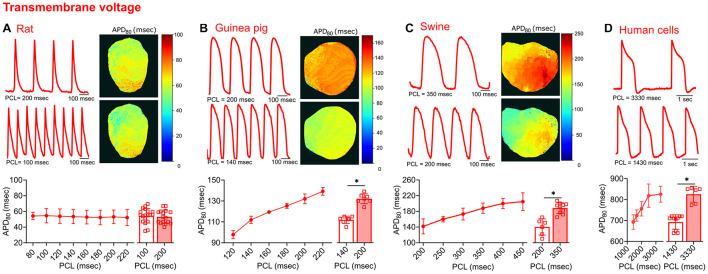FIGURE 4.
Transmembrane voltage measurements acquired from four different species. (A) Representative signals and APD80 maps from a rat heart paced at 200 and 100 ms PCL (top). Compiled restitution curve of APD80, in response to dynamic epicardial pacing (bottom left, n = 13–20 independent heart experiments). No change in APD80 was observed between 100 ms and 200 ms PCL (bottom right, n = 16–19 independent heart experiments). (B) Representative signals and APD80 maps from a guinea pig heart paced at 200 and 140 ms PCL (top). Compiled restitution curve of APD80, in response to dynamic epicardial pacing (bottom left, n = 5–7 independent heart experiments). Longer APD80 values observed at slower rates (200 vs. 140 ms PCL, n = 7 independent heart experiments). (C) Representative signals and APD80 maps from a swine heart paced at 350 and 200 ms PCL (top). Compiled restitution curve of APD80, in response to dynamic epicardial pacing (bottom left, n = 4–10 independent heart experiments). Longer APD80 values observed at slower rates (350 vs. 200 ms PCL, n = 6–10 independent heart experiments). (D) Representative signals from hiPSC-CM paced at 3330 and 1430 ms PCL (top). Compiled restitution curve of APD80, in response to field potential stimulation (bottom left, n = 6–15 independent cell preparations). Longer APD80 values observed at slower rates (3330 vs. 1430 ms PCL, n = 6–10 independent cell preparations). Values reported as mean ± SD. *p < 0.05, as determined by an unpaired Student’s t-test (two-tailed).

